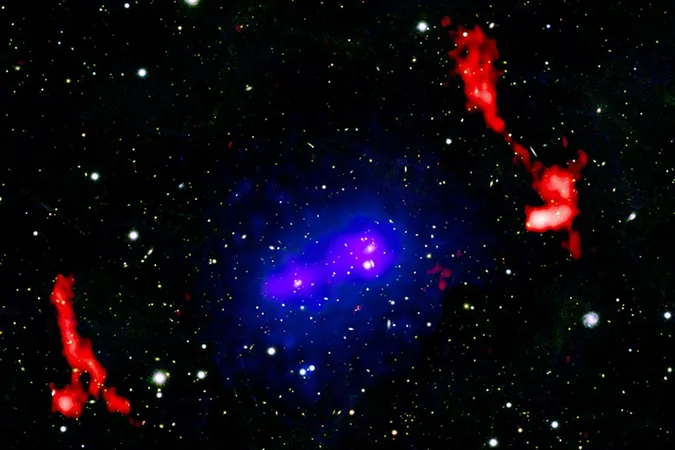
The Thrilling Race Towards Net Energy Gain in Nuclear Fusion
2025-01-06
Author: Michael
The Thrilling Race Towards Net Energy Gain in Nuclear Fusion
As the world embarks on the final stretch of a decades-long saga toward achieving net energy gain from nuclear fusion, the stakes have never been higher. Will nations close ranks and collaborate, or will fierce competition drive the breakthroughs necessary for this coveted goal?
Nuclear energy boasts efficiency, cleanliness, and reliability, yet concerns of catastrophic meltdowns—like those seen in Chernobyl in 1986 and Fukushima in 2011—have held back its widespread adoption. However, the urgent sustainability movement is giving renewed impetus to nuclear fusion research, igniting a race to harness the power of the stars for Earth’s benefit.
A Prize Beyond Measure: Clean Energy for All
Mastering nuclear fusion promises a virtually limitless supply of clean energy, potentially revolutionizing our approach to energy consumption and climate change. Unlike fission-based nuclear energy, fusion is a process that emits minimal greenhouse gases, providing a robust solution in combating global warming.
This transition to fusion energy carries significant economic and geopolitical implications. Countries harnessing this power could enjoy lower utility costs, making them attractive to businesses that prioritize sustainability. This can lead to job creation and more resilient economies. Furthermore, achieving a higher net energy yield enhances a nation's appeal to industries striving to meet Environmental, Social, and Governance (ESG) targets.
Self-sufficiency is another compelling benefit. Nations relying on imported energy face vulnerabilities—be it from price fluctuations or geopolitical tensions. Energy-independent countries can bolster their economic stability and public health by decreasing pollution and ensuring uninterrupted energy supplies.
The Challenges of Replicating Fusion on Earth
Despite its apparent promise, nuclear fusion is fraught with challenges. While fusion powers stars for billions of years, replicating this on Earth is immensely complex. The Sun’s gravity creates the extreme pressure and temperature necessary for hydrogen fusion, conditions not easily replicated on our planet.
To circumvent Earth’s less favorable conditions, scientists turn to heavier hydrogen isotopes—deuterium and tritium—as fuel. These fuels, while effective, present challenges of their own, such as the generation of radioactive waste and the requirement for extensive biological shielding. Tritium is particularly scarce, with resources needing to be carefully sourced, as it's generated only in limited quantities.
Additionally, nuclear fusion reactors face parasitic energy issues, requiring electricity to maintain plasma conditions essential for fusion. These complexities highlight the ongoing debate regarding the feasibility and sustainability of fusion as a viable energy source.
The International Fusion Race: US vs. China
As of now, nuclear fusion is still in the experimental phase, yet the competition between the United States and China is heating up. The U.S. has a historical head start in fusion research, beginning its efforts in the 1950s, but China has rapidly caught up since launching its own program in 2015.
Beijing has not only surpassed the U.S. in the number of fusion patents but is also outpacing American public investment in this area, committing $1.5 billion annually—double that of the United States. This surge may position China to overtake the U.S. in magnetic confinement fusion by 2027.
While private funding is more robust in the U.S.—bringing in $5.9 billion between 2022 and 2023—China's burgeoning landscape of fusion startups suggests that the East Asian country is not lagging behind. Notably, July 2023 saw a significant achievement in California, where scientists at Lawrence Livermore National Laboratory achieved a net energy gain from laser-based fusion, propelling the U.S. into the lead in this specific domain.
Collaboration at the Heart of Progress
Despite the competition, collaboration is equally vital in the nuclear fusion landscape. The International Thermonuclear Experimental Reactor (ITER) represents a remarkable example, with 33 countries collaborating to construct the world’s largest fusion experiment in France. This diverse coalition seeks to overcome the longstanding challenges associated with nuclear fusion, pooling resources and knowledge for a common goal.
In Southeast Asia, initiatives such as the ASEAN School on Plasma and Nuclear Fusion are crucial for cultivating new generations of researchers equipped to navigate this complex domain, demonstrating the global commitment to not just compete but also share advancements in fusion.
The Countdown to Sustainable Fusion Energy
Experts estimate that the pursuit of sustained net energy gain from fusion may extend into the 2030s or even the 2040s. The exact timeline remains uncertain, but one thing is clear: regardless of which nation—or nations—reach this milestone first, the global community stands to gain immensely.
The quest for near-limitless clean energy is not a zero-sum game, implying that everyone stands to profit from the advancements made in fusion technology. As we forge ahead, the world unites in hope—because the true victory will belong to humanity as we strive for a sustainable energy future.









 Brasil (PT)
Brasil (PT)
 Canada (EN)
Canada (EN)
 Chile (ES)
Chile (ES)
 Česko (CS)
Česko (CS)
 대한민국 (KO)
대한민국 (KO)
 España (ES)
España (ES)
 France (FR)
France (FR)
 Hong Kong (EN)
Hong Kong (EN)
 Italia (IT)
Italia (IT)
 日本 (JA)
日本 (JA)
 Magyarország (HU)
Magyarország (HU)
 Norge (NO)
Norge (NO)
 Polska (PL)
Polska (PL)
 Schweiz (DE)
Schweiz (DE)
 Singapore (EN)
Singapore (EN)
 Sverige (SV)
Sverige (SV)
 Suomi (FI)
Suomi (FI)
 Türkiye (TR)
Türkiye (TR)
 الإمارات العربية المتحدة (AR)
الإمارات العربية المتحدة (AR)